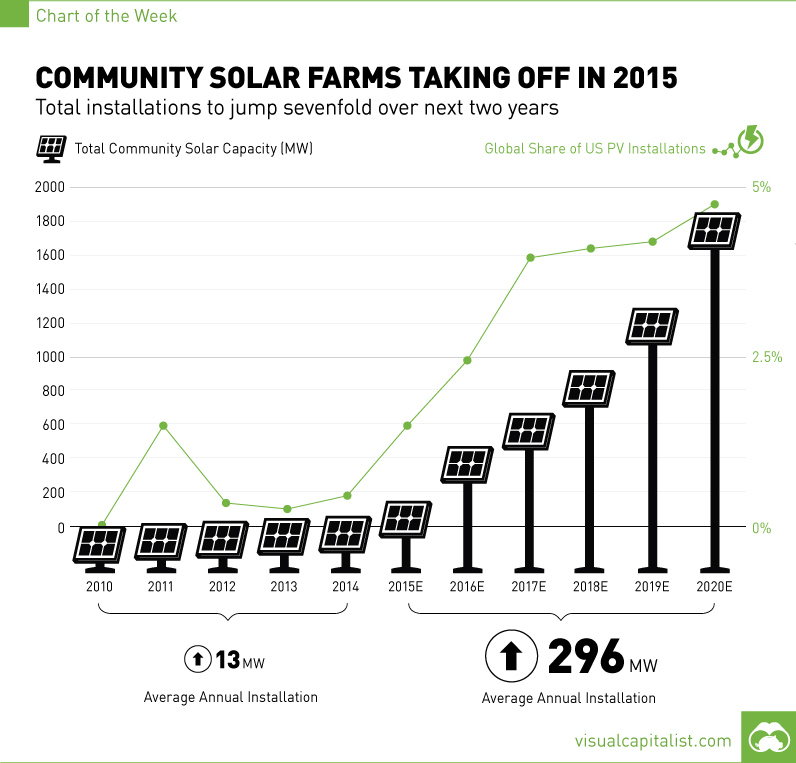Community Solar Farms Taking Off in 2015 [Chart]
Total installations of community solar farms to jump sevenfold in two years.
The Chart of the Week is a weekly feature in Visual Capitalist on Fridays. Through the last five years, on average there was only 13 MW of new community solar farm installations per year in the United States market. To put this in perspective, the country as a whole put in 6.2 GW of solar in the year of 2014. This basically gives the “community concept” of solar power the equivalent of a big fat zero on the scoreboard so far. GTM Research, a division of Greentech Media, anticipates that in 2015 that community solar farms will finally break new ground with 115 MW of new installations, doubling cumulative capacity. Then, over the following five years, a grand total of 1,663 MW of community solar is expected to be installed and operational in the United States with 80% of all installations occurring in California, Colorado, Massachusetts, and Minnesota. Community solar farms are a concept that tries to address some of the typical drawbacks of rooftop photovoltaic installations. For example, residential rooftop installations must have several factors align for optimal energy production: rooftop size and shape, the microclimate on property, adjacent buildings or trees, aesthetics, building codes, and zoning restrictions must all cooperate. In community solar farms, people pool their resources together to own panels or a percentage of solar power production at a given location. This concentrates production all in one place where none of the above concerns are an issue, and energy production is maximized. The company or organization operating the solar farm has the expertise to install and maintain panels which also helps optimize results.
on
#1: High Reliability
Nuclear power plants run 24/7 and are the most reliable source of sustainable energy. Nuclear electricity generation remains steady around the clock throughout the day, week, and year. Meanwhile, daily solar generation peaks in the afternoon when electricity demand is usually lower, and wind generation depends on wind speeds.As the use of variable solar and wind power increases globally, nuclear offers a stable and reliable backbone for a clean electricity grid.
#2: Clean Electricity
Nuclear reactors use fission to generate electricity without any greenhouse gas (GHG) emissions.Consequently, nuclear power is the cleanest energy source on a lifecycle basis, measured in CO2-equivalent emissions per gigawatt-hour (GWh) of electricity produced by a power plant over its lifetime. The lifecycle emissions from a typical nuclear power plant are 273 times lower than coal and 163 times lower than natural gas. Furthermore, nuclear is relatively less resource-intensive, allowing for lower supply chain emissions than wind and solar plants.
#3: Stable Affordability
Although nuclear plants can be expensive to build, they are cost-competitive in the long run. Most nuclear plants have an initial lifetime of around 40 years, after which they can continue operating with approved lifetime extensions. Nuclear plants with lifetime extensions are the cheapest sources of electricity in the United States, and 88 of the country’s 92 reactors have received approvals for 20-year extensions. Additionally, according to the World Nuclear Association, nuclear plants are relatively less susceptible to fuel price volatility than natural gas plants, allowing for stable costs of electricity generation.
#4: Energy Efficiency
Nuclear’s high energy return on investment (EROI) exemplifies its exceptional efficiency. EROI measures how many units of energy are returned for every unit invested in building and running a power plant, over its lifetime. According to a 2018 study by Weissbach et al., nuclear’s EROI is 75 units, making it the most efficient energy source by some distance, with hydropower ranking second at 35 units.
#5: Sustainable Innovation
New, advanced reactor designs are bypassing many of the difficulties faced by traditional nuclear plants, making nuclear power more accessible.
Small Modular Reactors (SMRs) are much smaller than conventional reactors and are modular—meaning that their components can be transported and assembled in different locations. Microreactors are smaller than SMRs and are designed to provide electricity in remote and small market areas. They can also serve as backup power sources during emergencies.
These reactor designs offer several advantages, including lower initial capital costs, portability, and increased scalability.
A Nuclear-Powered Future
Nuclear power is making a remarkable comeback as countries work to achieve climate goals and ultimately, a state of energy utopia. Besides the 423 reactors in operation worldwide, another 56 reactors are under construction, and at least 69 more are planned for construction. Some nations, like Japan, have also reversed their attitudes toward nuclear power, embracing it as a clean and reliable energy source for the future. CanAlaska is a leading exploration company in the Athabasca Basin, the Earth’s richest uranium depository. Click here to learn more now. In part 3 of the Road to Energy Utopia series, we explore the unique properties of uranium, the fuel that powers nuclear reactors.






























